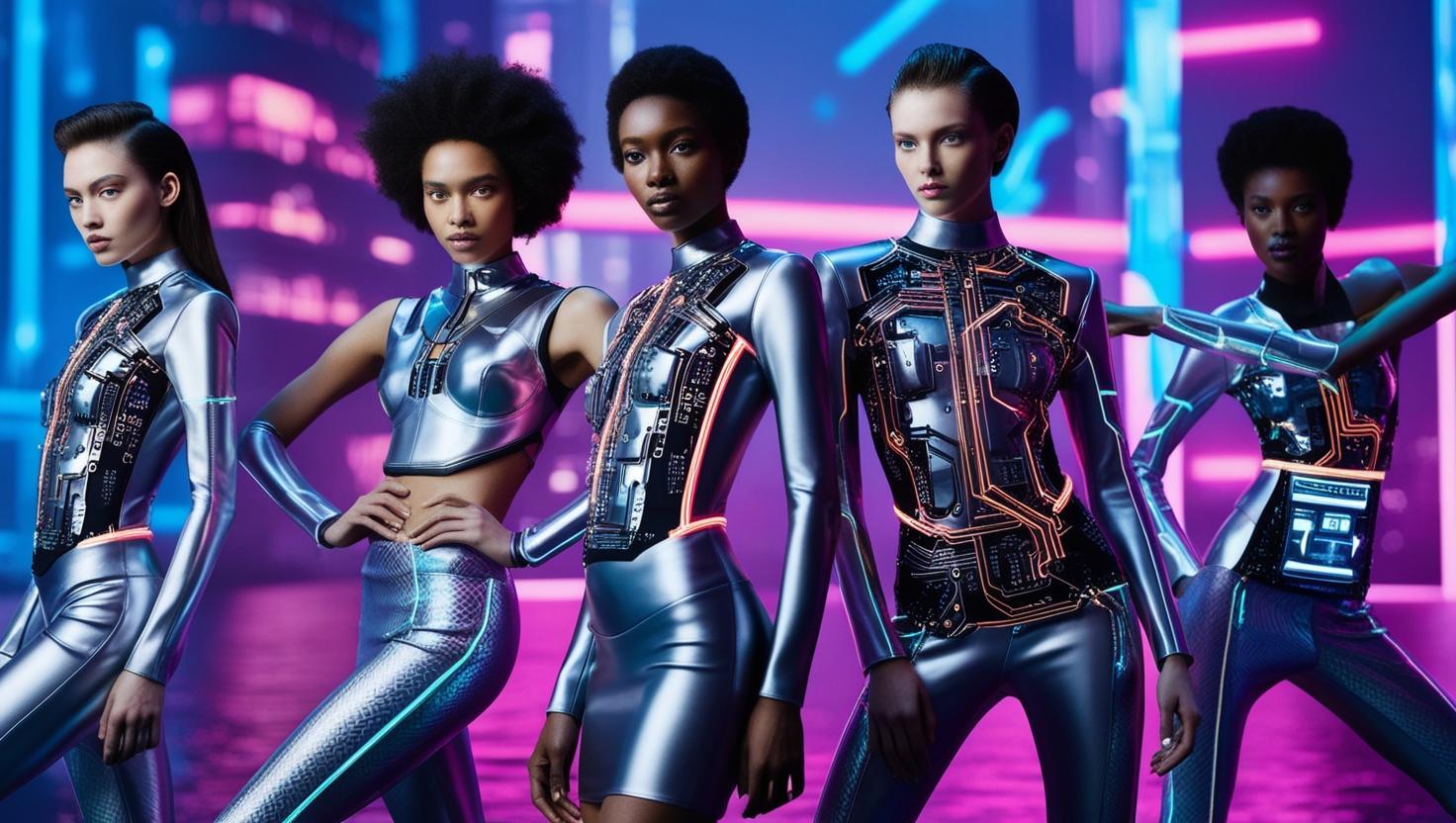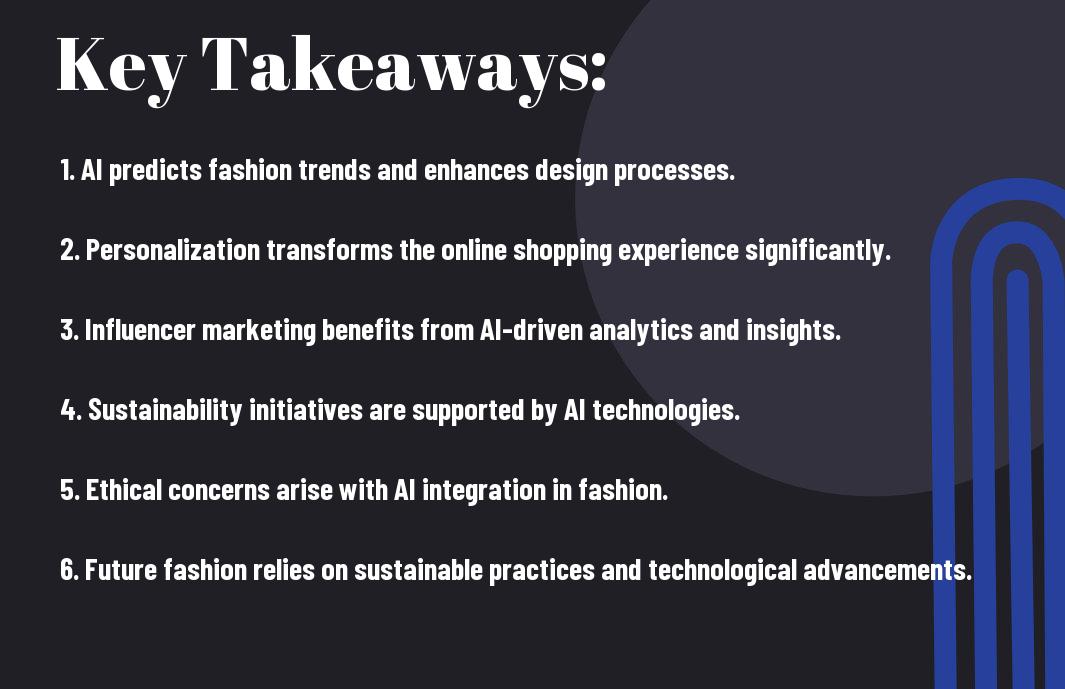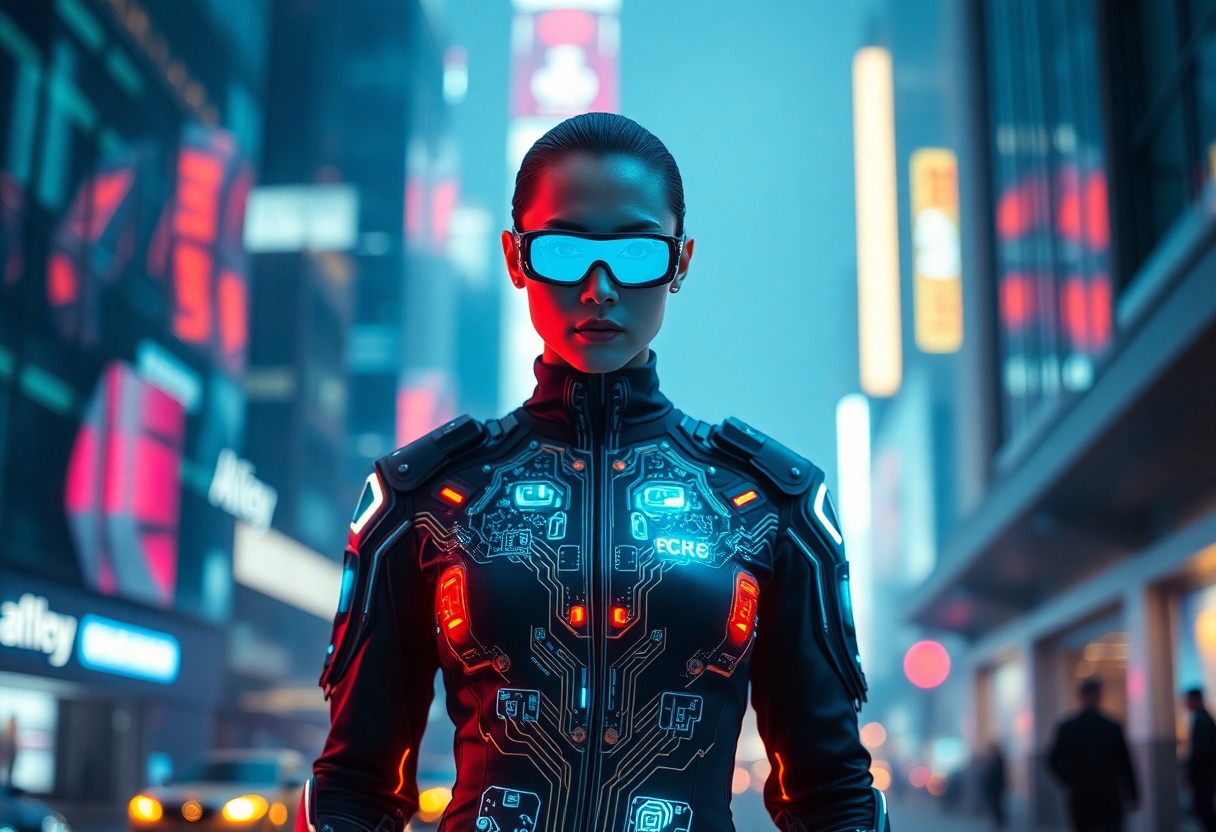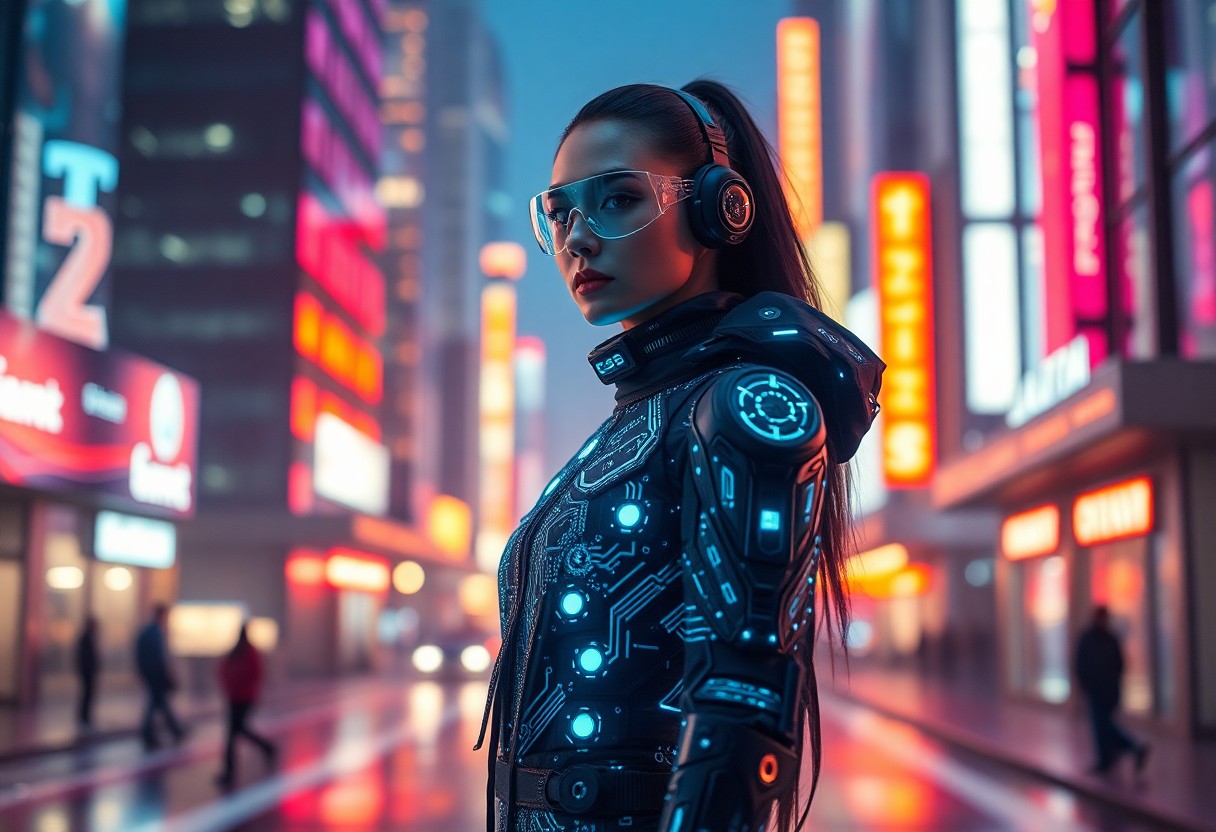28th Mar 2025
Cyber Couture: The Futuristic Fusion of Fashion and Technology

Cyber innovation reshapes your wardrobe, merging fashion and technology to create an unparalleled experience. You’ll discover that smart textiles, wearable tech, and 3D printing are revolutionizing how you express yourself through clothing. As you probe into this exciting realm, you'll find that the fusion of style and technology not only enhances your aesthetic but also promotes sustainability and personalization. However, you should also be aware of the ethical implications and data privacy concerns that come with these advancements, making informed choices crucial in your fashion journey.
The Rise of AI in Fashion
Before the advent of AI, fashion design was primarily an art, influenced by past trends and designers' instincts. Now, AI is reshaping the landscape, enabling brands to leverage data-driven insights for more effective decision-making. By analyzing vast data sets, AI can forecast trends, streamline production, and enhance overall efficiency, making it an indispensable tool in the industry.
Trend Prediction and Design Innovation
Against a backdrop of constantly changing consumer preferences, AI stands out by offering unparalleled trend prediction capabilities. Tools like IBM's Watson analyze online data, allowing designers to craft collections that align with real-time consumer interests, minimizing the risks associated with unpredictable fashion cycles.

Personalization in the Shopping Experience
Innovation in AI technology is transforming your shopping experience by offering personalized recommendations that cater specifically to your preferences. As AI integrates with online platforms, you receive tailored suggestions that resonate with your style, significantly boosting your engagement and satisfaction.
A personalized shopping experience not only enhances your choices but also contributes to a more enjoyable journey. AI analyzes your *past purchases* and browsing habits to offer highly relevant suggestions, allowing you to discover pieces that suit your taste. With AI's ability to create *virtual try-on experiences*, you can visualize products in real-time, bridging the gap between online and in-store shopping. This technology is projected to elevate AI's impact in the fashion market from *$270 million in 2018 to $4.4 billion by 2027*, highlighting its importance in shaping your purchasing decisions.

The Role of Virtual Reality and Augmented Reality
One of the most exciting developments in fashion technology is the integration of virtual reality (VR) and augmented reality (AR). These innovations enable immersive experiences that reshape how you interact with fashion. From virtual fitting rooms to AR-enhanced shopping apps, these technologies allow you to visualize garments in real time, transforming the old shopping experience into a digital playground where style meets convenience.
Immersive Shopping Experiences
An immersive shopping experience allows you to engage with products like never before. By using AR, you can virtually try on outfits from the comfort of your home, view items in 3D, and receive personalized recommendations. This technology enhances your decision-making process by offering a tailored experience that mirrors in-store interactions, making your shopping journey smoother and more enjoyable.
Virtual Fashion Shows and Showrooms
Against the backdrop of traditional fashion events, virtual fashion shows and showrooms are pioneering a new era. By leveraging VR and AR, these shows allow you to attend and experience high-profile events from anywhere in the world. You can explore collections up close and personally engage with designers in virtual spaces. Data suggests that the global AR market in the fashion sector is projected to reach $4.4 billion by 2027, emphasizing its growing importance. Shows not only democratize access to fashion, but they also reduce environmental impact by minimizing travel and resources, showcasing how technology can transform the industry for the better.
Sustainability through Technology
Despite the fashion industry’s reputation for excess, technology is paving the way for a more sustainable future. Advanced AI-driven solutions are optimizing supply chains and promoting eco-friendly practices, allowing you to embrace style without compromising the planet. By leveraging data, brands are transitioning to sustainable materials and ethical production methods that benefit both consumers and the environment, reducing the sector’s significant impact on global carbon emissions and wastewater.
Eco-friendly Materials and Practices
Sustainability in fashion starts with the materials. By utilizing organic fabrics, recycled textiles, and plant-based dyes, you can support brands that prioritize the environment. These materials not only reduce the reliance on harmful chemicals but also promote a circular economy where waste is minimized. As you choose eco-friendly options, you contribute to a movement that values both style and sustainability.
Reducing Waste with Smart Manufacturing
Materials that drive innovation in fashion are crucial for reducing waste. To achieve this, many brands are adopting smart manufacturing techniques, such as AI and data analytics, that predict demand and streamline production processes. This not only minimizes overproduction but also increases efficiency, resulting in a potential addition of $150 billion to the fashion industry profits by 2027. By optimizing the use of resources and employing just-in-time production methods, brands can significantly lower environmental impacts while delivering high-quality, stylish products.

Data Privacy and Ethical Considerations
For the fashion industry to fully embrace technological advancements, you must be aware of the data privacy and ethical implications involved. As AI becomes more intertwined with fashion, the handling of consumer data raises significant concerns regarding user privacy and the ethical use of information. You should prioritize transparency and responsible data management to foster a relationship built on trust and accountability.
Consumer Trust and Data Management
Trust is crucial in today's digital landscape. As brands utilize AI to personalize experiences and drive sales, it’s vital to ensure that your data is managed responsibly. By implementing strict privacy policies and communicating openly about data usage, you will strengthen your relationship with consumers, encouraging loyalty and promoting a positive brand image.
Addressing Bias in AI Algorithms
Ethical considerations around AI algorithms demand your attention, particularly regarding potential biases that can emerge from data analysis. If left unchecked, these biases can reinforce harmful stereotypes and lead to skewed fashion trends—ultimately impacting consumer choices. Further, you will want to focus on diversifying data sources and continuously auditing AI models for bias. This ensures that AI-driven insights reflect fair representation, which not only promotes inclusivity within your brand but also enhances overall consumer satisfaction. By doing so, you actively contribute to a more ethical and equitable fashion landscape, while empowering diverse voices within the industry.

The Future of Fashion Tech
Now is the time to embrace the rapidly evolving intersection of fashion and technology. As designers and brands integrate innovative tools like artificial intelligence into their workflows, you'll witness significant shifts in production, marketing, and consumer interactions. With these changes, your shopping experiences will become more personalized, efficient, and aligned with contemporary trends, shaping the way you connect with fashion.
Emerging Technologies on the Horizon
Technologies such as virtual reality, augmented reality, and blockchain are reshaping the fashion landscape. These tools promise to enhance your online shopping experience with realistic try-ons and provide transparency in sourcing and ethical practices. As brands begin to adopt these innovations, you can expect to engage with fashion like never before, with immersive experiences and trustworthy information at your fingertips.
Predictions for the Next Decade
Future advancements in fashion technology may revolutionize the industry further. Over the next ten years, you could see the emergence of fabrics that actively change color based on your mood, wearable technology that provides health insights, and AI-driven platforms that curate your wardrobe based on your lifestyle. These innovations will paint a bright picture for sustainability, allowing you to make informed, eco-friendly choices while enjoying an unparalleled shopping experience.
Further, this evolving landscape will bring both exciting opportunities and challenges. As brands harness the power of AI and other technologies, the potential for improved sustainability practices, such as reducing waste and optimizing supply chains is significant. However, with change comes responsibility—ethical concerns regarding data privacy and labor practices may surface. It's important for you to stay informed and advocate for transparency and ethics in your favorite brands, ensuring that your fashion choices contribute positively to the industry.
Case Studies of Fashion Tech Brands
After examining the intersection of fashion and technology, you’ll find compelling case studies highlighting innovative brands. These examples illustrate the transformative power of tech in the industry:
- IBM’s Watson Trend App: Analyzes online data to predict fashion trends, influencing design collections.
- Statista Data: The global AI in the fashion market reached $270 million in 2018 and is projected to grow to $4.4 billion by 2027.
- Heuritech: Utilizes AI to analyze social media images, helping brands like Louis Vuitton and Dior anticipate trends.
- McKinsey’s Projection: Generative AI could add $150 billion to $275 billion in profits to the fashion sector over the next 3-5 years.
Innovators Leading the Way
By staying at the forefront of merging technology and fashion, you’ll discover innovators like No Nasties and B Label, who utilize eco-friendly materials and advanced algorithms, respectively, to reshape industry standards. These brands exemplify sustainable practices while embracing cutting-edge technology to bolster their offerings.
Successful Collaborations Between Designers and Tech Firms
On your journey through fashion-tech collaborations, you’ll witness partnerships that elevate design processes and enhance consumer experiences. By combining creative visions with technological expertise, brands gain new insights into consumer preferences, leading to unique product offerings and heightened market engagement.
Further, these collaborations can result in significant advancements in the industry. For example, partnerships among leading brands and tech firms foster data-driven approaches to design and marketing, enhancing personalization in shopping experiences. These alliances also address sustainability challenges by promoting efficient supply chains and launching eco-friendly initiatives. The blend of creativity and technology opens up pathways for innovation, giving you access to a fashion landscape that values ethics alongside style.
Summing Up
With these considerations, you can see how the fusion of fashion and technology is shaping the future in exciting ways. As you explore Cyber Couture, you’ll recognize the potential for innovative designs, personalized shopping experiences, and sustainable practices through AI and other technologies. This evolving intersection invites you to rethink your fashion choices and embrace a mindful approach that values both style and sustainability in your wardrobe.
